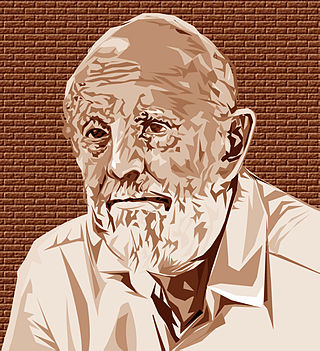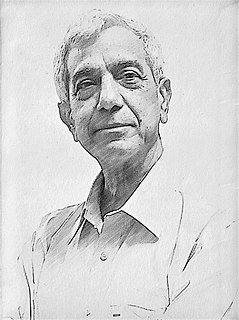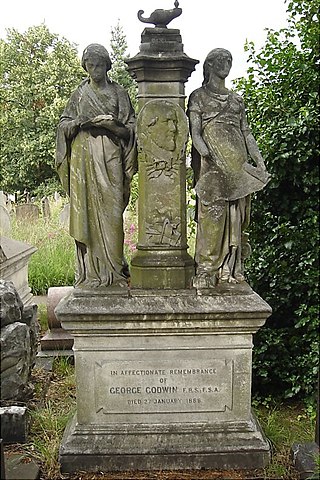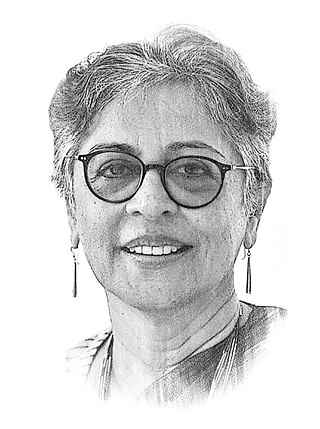
An architect is a person who plans, designs and oversees the construction of buildings. To practice architecture means to provide services in connection with the design of buildings and the space within the site surrounding the buildings that have human occupancy or use as their principal purpose. Etymologically, the term architect derives from the Latin architectus, which derives from the Greek, i.e., chief builder.

Vastu shastra is a traditional Indian system of architecture based on ancient texts that describe principles of design, layout, measurements, ground preparation, space arrangement, and spatial geometry. The designs aim to integrate architecture with nature, the relative functions of various parts of the structure, and ancient beliefs utilising geometric patterns (yantra), symmetry, and directional alignments.

Lawrence Wilfred "Laurie" Baker was a British-born Indian architect, renowned for his initiatives in cost-effective energy-efficient architecture and designs that maximized space, ventilation and light and maintained an uncluttered yet striking aesthetic sensibility. Influenced by Mahatma Gandhi and his own experiences in the remote Himalayas, he promoted the revival of regional building practices and use of local materials; and combined this with a design philosophy that emphasized a responsible and prudent use of resources and energy. He was a pioneer of sustainable architecture as well as organic architecture, incorporating in his designs even in the late 1960s, concepts such as rain-water harvesting, minimizing usage of energy-inefficient building materials, minimizing damage to the building site and seamlessly merging with the surroundings. Due to his social and humanitarian efforts to bring architecture and design to the common man, his honest use of materials, his belief in simplicity in design and in life, and his staunch Quaker belief in non-violence, he has been called the "Gandhi of architecture".

Balkrishna Vithaldas Doshi OAL is an Indian architect. He is considered to be an important figure of Indian architecture and noted for his contributions to the evolution of architectural discourse in India. Having worked under Le Corbusier and Louis Kahn, he is a pioneer of modernist and brutalist architecture in India.

Architectural Record is a US-based monthly magazine dedicated to architecture and interior design. "The Record," as it is sometimes colloquially referred to, is widely-recognized as an important historical record of the unfolding debates in architectural practice, history and criticism in the 20th-century United States. The magazine is currently published by BNP Media. Throughout its 125 years in print, Architectural Record has engaged readership among architecture, engineering, and design professionals through articles showcasing noteworthy architectural project around the world. News, commentary, criticism, and continuing-education sections outline the scope of content. Of note are the glossy, high-quality photos of featured projects, which makes the magazine wider readership outside of just those working in the design professions.

Christopher Charles Benninger is one of India's highly decorated architects. His award-winning projects are, The Mahindra United World College of India, The Samundra Institute of Maritime Studies, The Suzlon One Earth world headquarters, The National Ceremonial Plaza at Thimphu, Bhutan and India House, architects' residence and design studio.

Krishnarao Jaisim is an architect and the former chairman of the Indian Institute of Architects, Karnataka Chapter. His work has been featured in The New York Times, The Hindu, The Times of India, The Deccan Herald, and on HGTV.

In the United States, an architectural firm or architecture firm is a business that employs one or more licensed architects and practices the profession of architecture; while in South Africa, the United Kingdom, Ireland, Denmark and other countries, an architectural firm is a company that offers architectural services.

George Godwin FRS was an influential British architect, journalist, and editor of The Builder magazine.

Joseph Stein was an American architect and a major figure in the establishment of a regional modern architecture in the San Francisco Bay area in the 1940s and 1950s during the early days of the environmental design movement. In 1952, he moved to India and in 1955 was tasked with the planning of Durgapur in West Bengal, India along with Benjamin Polk. He was commissioned with this task in order to facilitate the establishment of Durgapur Steel Plant later on in 1959 followed by the Durgapur Steel City and Township. He is noted for designing several important buildings in India, most notably in Lodhi Estate in Central Delhi, nicknamed "Steinabad" after him, and where today the 'Joseph Stein Lane', is the only road in Delhi named after an architect. He is also famous for being the architect of the scenic Indian Institute of Management Kozhikode's campus. The Government of India awarded him the fourth highest civilian award of Padma Shri in 1992. His works remain even more relevant in the modern context as need for sustainable and humane architecture is felt.

Eugene Pandala is an Indian architect, known for building with values of environmental sustainability.
Sheila Sri Prakash is an architect and urban designer of Indian origin. She is the founder of Shilpa Architects and is the first woman in India to have started and operated her own architectural practice.

Syed Mahmood Khundmiri was an Indian Urdu language poet, humorist, architect, artist, orator, and one of the leading Urdu poets of the 20th and 21st centuries. He concentrated on humorous poetry, and was considered among the elite of Urdu humor. He died of cardiac arrest on 16 January 2011, in Pune, Maharashtra, India)

Brinda Somaya is an Indian architect and urban conservationist.

Bimal Hasmukh Patel is an architect from Gujarat, India, with over 35 years of professional, research and teaching experience in architecture, urban design and urban planning. He is President of CEPT University in Ahmedabad and leads HCP Design Planning and Management Private Limited, an architecture, planning and project management firm. He also founded Environmental Planning Collaborative, a not-for-profit, planning research and advocacy organization.

Sattanatha Muthiah Ganapathi, popularly known as S. M. Ganapathi sthapathi, was an Indian architect and builder (sthapati) of traditional Hindu temple architecture. He was known for his contribution in saving 48 archaeologically important temples near the Nagarjun Sagar reservoir from submergence. Orirukkai Manimantapam, Ramalayam and Kalyana Mandapam at Bhadrachalam and the Mahamantapam of the Badrinath Temple are some of his notable creations. The Government of India awarded him the fourth highest civilian award of Padma Shri in 1990.
Muthiah Sthapati is an Indian sculptor, architect and builder of Hindu temple architecture. He is known for the design and construction of several temples in the UK and US, including the Hindu Temple of Minnesota. He is the creator of the 67.5-foot Buddha statue at Rambadagalla Vidyasagara Temple, in Sri Lanka, reported to be world's largest Buddha statue in the seated (samadhi) position. The Government of India awarded him the fourth highest civilian award of Padma Shri in 1992.

Anupama Kundoo is an Indian architect.

Iftikhar M. Kadri is an Indian architect, civil engineer, and founder of I.M.K Architects in the city of Mumbai, India. He has been a key figure in contributing to world renowned landmark buildings in several cities of India, United States, Russia, Middle East, Hong Kong & among others around the world.

Karl Damschen is an architect working in Switzerland and mainly in Kerala, India. His buildings are grounded in the climatic and historico-cultural conditions of each place, and they are significant for the recognition of the great architectural resources of India.

















